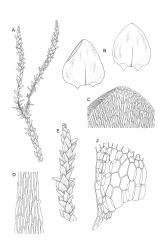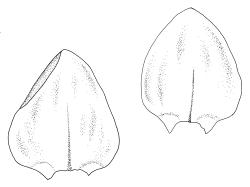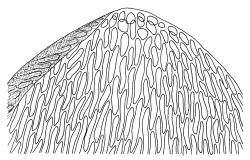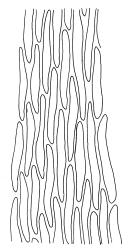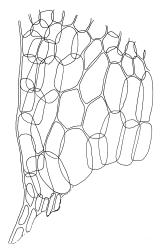- ≡ Stereodon richardsonii Mitt., J. Linn. Soc., Bot. 8: 42 (1864)
- = Calliergon subpapillosum Karczm., Monogr. Bot. 34: 68 (1971)
Plants robust, brown-green, forming extensive mats. Stems irregularly branched, to c. 50–100 mm. Stem leaves spreading, ± remote, broadly ovate, broadly rounded and cucullate at apex, weakly striolate to nearly smooth when dry, weakly decurrent, 2.3–3.5 × 1.4–1.9 mm, with abaxial rhizoids mostly absent in N.Z. material; upper laminal cells linear-rhombic, mostly 60–75 × 6–9 µm, not or very weakly porose; alar cells abruptly differentiated from adjacent laminal cells, forming a large, excavate, and decurrent group which extends ⅔ to ¾ to the costa base; costa simple or weakly forked above, variable in length in N.Z. material, mostly failing (½–)⅔(–⅞) to leaf apex. Branches sparse and irregular to nearly lacking, cuspidate. Branch leaves distinctly narrower than stem leaves.
Autoicous? Sex organs and sporophytes not seen in N.Z. material.
Calliergon richardsonii in N.Z. is perhaps most likely confused with the unrelated Bryum blandum. Calliergon richardsonii is a more robust and larger-leaved species. Also, the leaves in the present species lack a differentiated marginal border and have stouter costae which end further below the leaf apex than do those of the Bryum.
SI: Nelson (Lake Cobb), Canterbury (Lake Tennyson, Lake Waitaki), Otago (Diamond Lake, Lammermoor Range), Southland (Te Ānau).
Bipolar? Widespread in the northern hemisphere.
Forming extensive mats, sometimes submerged, on the margins of subalpine lakes (Lake Cobb) and streams (as at Lake Tennyson). Also recorded from a "wet Sphagnum-sedge-grass bog" (Lammermoor Range) and from beneath willows on the shore of Lake Waitaki. Recorded from 230 (Lake Waitaki) to 1125 m (Lake Cobb). Karczmarz (1971, p. 70) indicated this species occurs in sites "characterized by low pH" in the northern hemisphere, while Crum & Anderson (1981, p. 1003) were "inclined to think of the species as a calciphile." The species is very little known in N.Z.; the Lake Cobb site has a bedrock of apparently nutrient poor indurated siltstone. At Lake Tennyson C. richardsonii has been collected growing submerged at a depth of 20 to 30 m (de Winton & Beever 2004). Associated species include Bryum laevigatum, Calliergonella cuspidata, and Drepanocladus aduncus. The possibility that both indigenous and adventive populations occur cannot be wholly dismissed.
Neither sex organs nor sporophytes have been seen in N.Z. material; this species is reported by Crum & Anderson (1981, p. 1003) as "autoicous (or, rarely polygamous, the perigonia including a few archegonia)".
The earliest collection from N.Z. appears to be W. Bell's 1892 collection from Diamond Lake (Otago L.D.) which is the type of C. subpapillosum. This Bell collection is, unusually, not represented in the Beckett herbarium at CHR.
Calliergon richardsonii was first recorded from N.Z. by Bartlett (1984), who cited material from Lake Cobb and Lake Manapōuri (Southland). These collections were apparently named by either Kanda or Karczmarz. The Manapōuri collection has been unavailable for study. Karczmarz named a Bartlett collection (cf. AK 179755) from Lake Cobb as C. richardsonii var. robustum; this determination is not followed here. Bartlett (1984) also concluded that Karczmarz’s varietal determination was superfluous.




